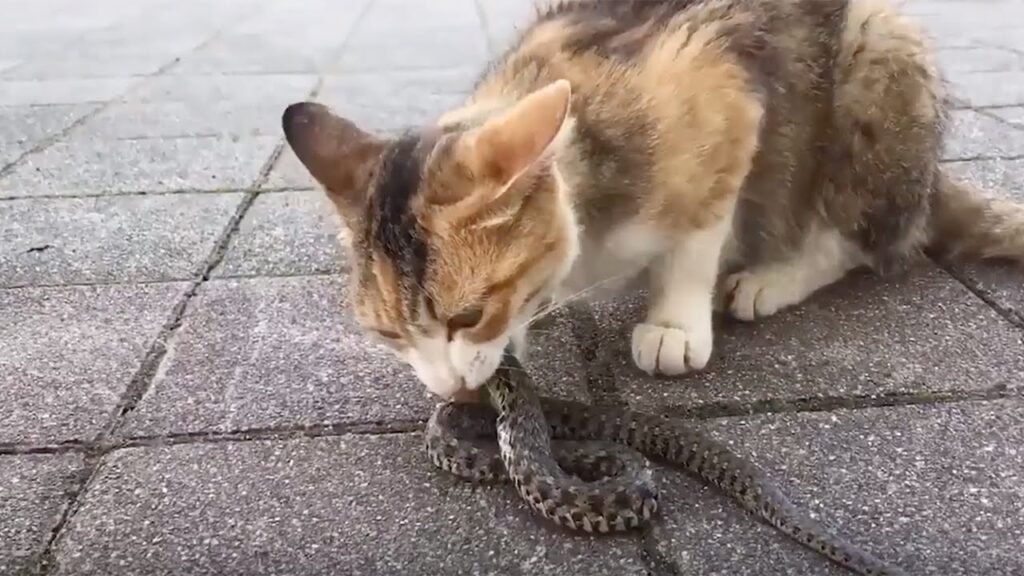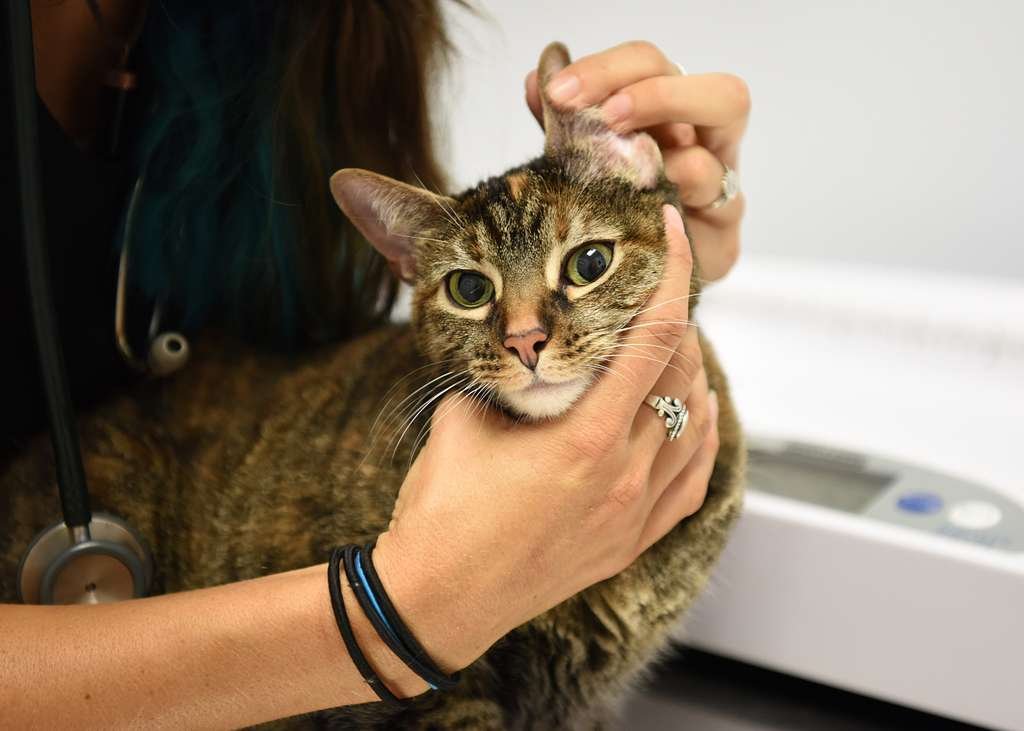


How Big Can Guinea Pigs Get? (Different Breeds Compared)
February 29, 2024


Can Guinea Pigs See Color and What Colors Can They See?
March 5, 2024Cats are known for their curiosity and hunting skills. They often chase and play with anything that moves, from toys to small animals. This includes snakes, making the interaction between cats and snakes a fascinating topic. Understanding how these two creatures interact can help pet owners keep their furry friends safe and healthy.
It also sheds light on cats’ instincts, showing how their environment and the animals around them influence their behavior. This blog explores whether cats can kill snakes and what this means for pets and their owners.
Can cats kill snakes?
Yes, cats can kill snakes. Their natural hunting instincts and agile movements enable them to catch and kill small snakes. However, the ability to kill snakes depends on the snake’s size, type, and the cat’s experience. While cats may successfully hunt non-venomous snakes, venomous snakes pose a significant risk.
Cats possess innate hunting instincts that date back to their ancestors. These instincts compel them to stalk, pounce, and play with their prey, behaviors that are crucial for survival in the wild. Regarding snakes, cats often perceive them as potential prey due to their movement patterns.
A snake’s quick, slithering motion can trigger a cat’s predatory response, leading them to attack. However, this interaction is influenced by the cat’s experience and the type of snake encountered.
While still retaining their ancestral hunting instincts, domestic cats may not always distinguish between venomous and non-venomous snakes, putting them at risk during such encounters. This behavior showcases the complex interplay between a cat’s innate predatory skills and the potential dangers of engaging with wild animals like snakes.


Can cats kill snakes?
Related Read: What happens when a cat eats a snake? Things you should know
What types of snakes are most likely to be hunted by cats?
Cats are more inclined to hunt non-venomous snakes due to their safer, easier targets. The types of snakes cats encounter can vary by their geographic location.
- Non-venomous Snakes: Examples include garter snakes, corn snakes, and rat snakes. These are often found in gardens and fields, making them common cat targets.
- Venomous Snakes: While less common, encounters with venomous snakes like copperheads, rattlesnakes, or vipers can occur, especially in regions where these snakes are native.
- Small to Medium-Sized Snakes: Regardless of whether they are venomous, cats are more likely to hunt smaller snakes due to the ease of overpowering them than larger ones.
- Snakes in Accessible Areas: Cats typically encounter snakes that inhabit areas close to human dwellings, such as gardens, barns, or forests near residential areas.
Also, Read: Can A Dog Sense Snakes? Everything You Need to Know!
What happens when a snake bites your cat?
When a snake bites your cat, the reaction can vary significantly depending on whether the snake is venomous or non-venomous.
Recognizing the signs and the potential consequences is crucial for ensuring your pet receives timely and appropriate care.
For Non-Venomous Snake Bites:
- Puncture Wounds: Look for minor puncture marks where the snake’s teeth have penetrated the skin.
- Swelling and Pain: The bite area may become swollen and painful to the touch.
- Bleeding: Some bleeding may occur at the bite site.
- Infection Risk: While not immediately life-threatening, non-venomous bites can lead to infections if not properly cleaned and monitored.
For Venomous Snake Bites:
- Rapid Swelling: Swelling at the bite site can be quick and extensive.
- Severe Pain: Intense pain at the bite location is common.
- Lethargy and Weakness: The cat may show signs of weakness lethargy, and appear uncoordinated.
- Vomiting and Drooling: Some cats may vomit or drool excessively after a venomous bite.
- Breathing Difficulties: In severe cases, breathing difficulties can occur, indicating potential systemic effects of the venom.
- Neurological Symptoms: Depending on the type of venom, there may be neurological symptoms, such as twitching, shaking, or seizures.
Must Read: Can snakes eat themselves to death?
How do cats protect themselves from snake bites?
Cats use several natural defensive mechanisms to protect themselves against snake bites. These innate skills are part of their survival instinct, allowing them to fend off or escape potential threats, including snakes.
- Agility and Speed: Cats are incredibly agile and quick. They can make rapid and unpredictable movements to dodge snake strikes. This agility lets them position themselves advantageously during encounters, potentially avoiding bites altogether.
- Claws and Teeth: Cats use their sharp claws and teeth for hunting and defense. They can deliver powerful swipes with their claws or bites, aiming to injure or intimidate the snake, deter an attack, or reduce the seriousness of an encounter.
- Heightened Senses: Cats have highly developed senses, including acute hearing and vision, which alert them to the presence of snakes, often before the snake has a chance to strike. Their whiskers can detect minute changes in air currents, helping them sense movements and react swiftly.
- Defensive Posturing: When threatened, a cat may adopt a defensive posture, arching its back, puffing up its fur, and hissing or growling to appear larger and more intimidating to a snake. This behavior can sometimes deter a snake from attacking.
- Evasion: If given the opportunity, a cat’s best defense against a snake bite is to avoid the encounter altogether. Their instinctual evaluation of risk versus reward may lead them to retreat from a snake perceived as too dangerous.


Can cats eat snakes?
What should you do if your cat catches or kills a snake?
If your cat catches or kills a snake, it’s important to handle the situation carefully to ensure your and your cat’s safety. Here are the steps you should follow:
Keep Calm and Separate Your Cat from the Snake
Gently remove your cat from the snake’s vicinity to prevent further interaction. This is important even if the snake appears dead, as some snakes can reflexively bite for a short time after death.
Identify the Snake (If Possible)
If you can safely photograph the snake from a distance, do so. Identification can be crucial in determining the necessary action, especially if the snake is venomous. However, do not attempt to capture or handle the snake yourself.
Check Your Cat for Injuries
Look for signs of snake bites, such as puncture wounds, swelling, or bleeding. Even if there are no visible signs of a bite, monitor your cat closely for symptoms of envenomation, which can include lethargy, drooling, vomiting, or difficulty breathing.
Contact Your Veterinarian Immediately
If you suspect your cat has been bitten, or if you have any concerns about their health following an encounter with a snake, seek veterinary care immediately. Provide your vet with as much information as possible, including the type of snake, if known, and the symptoms your cat is exhibiting.


Cat with a Vet
Follow Veterinary Advice
Your veterinarian may recommend bringing your cat in for an examination, treatment, or observation. Follow their advice closely, including administering prescribed medications and attending follow-up appointments.
Safely Dispose of the Snake
If the snake is dead, it’s essential to dispose of it safely to prevent any risk to others. Use a long-handled shovel, place it in a sealed bag or air-tight container, and dispose of it according to local regulations. Avoid direct contact with the snake, as venomous snakes can still pose a risk even after death.
Prevent Future Encounters
Take steps to make your yard less attractive to snakes by removing debris, sealing gaps in foundations, and keeping grass trimmed. Consider keeping your cat indoors, especially in areas known for venomous snakes, to prevent future encounters.
Also, Read: Can Snakes Grow Their Tails Back? (Answers & Facts)
How do you protect your cat from hunting snakes?
Preventing cats from hunting snakes involves a combination of safety measures, environmental modifications, and behavioral training. Here are some strategies to help keep both your cat and local snake populations safe:
Keep Your Cat Indoors
The simplest way to prevent encounters with snakes is to keep your cat indoors. Indoor cats are less likely to contact snakes and other potentially dangerous wildlife.
Supervised Outdoor Time
Consider supervised outings in a secure, enclosed area if you allow your cat outside. Catios (cat patios) or leashed walks can provide safe outdoor experiences without the risk of encountering snakes.
Environmental Modifications
- Clear Debris: Remove piles of rocks, wood, and leaves where snakes may hide.
- Trim Grass: Keep your lawn short and bushes trimmed to reduce cover for snakes.
- Seal Gaps: Ensure that sheds, garages, and other outdoor buildings are sealed to prevent snakes from seeking shelter there.
Behavioral Training
- Discourage Hunting: Discourage your cat from hunting by providing ample playtime with toys that satisfy their hunting instincts.
- Use Commands: Train your cat to respond to commands or noises that call them away from potential danger.
Provide Entertainment
Keep your cat entertained indoors with toys, climbing structures, and interactive games to reduce their desire to go outside and hunt.
Safety Collars
If your cat goes outdoors, consider a brightly colored, breakaway safety collar with a bell to warn wildlife of their approach, potentially deterring snake encounters.


Cat Safety Collar with a Bell
Regular Check-ups
Ensure a vet regularly checks your cat and is up-to-date with vaccinations and parasite control. This is essential for their overall health and reduces the risks associated with wildlife encounters.
Educate Yourself
Learn about the local snake species in your area, especially venomous ones. This knowledge can help you take more specific precautions to protect your cat and understand what to do if an encounter occurs.
FAQs
Can a cat’s instincts to hunt snakes be eliminated?
It’s challenging to eliminate a cat’s natural hunting instincts, as these behaviors are deeply ingrained. However, you can significantly reduce their urge to hunt through consistent training, environmental management, and providing alternative forms of stimulation.
Are certain breeds of cats more likely to hunt snakes than others?
While hunting instincts are common across all cat breeds, some breeds may exhibit stronger predatory behaviors due to their higher energy levels and more pronounced hunting instincts. Species such as Bengals, Siamese, and Savannahs might be more inclined to hunt, including pursuing snakes.
What should I do if I live in an area with a high population of venomous snakes?
If you live in an area known for venomous snakes, prioritize keeping your cat indoors to avoid encounters. Additionally, you can work with local wildlife experts to make your property less inviting to snakes and educate yourself on emergency procedures in case of a snake bite.
How can I tell if my cat has been trained effectively to avoid snakes?
Effective training may be indicated by your cat showing disinterest or cautious behavior around snakes or snake-like objects. However, it’s important to remember that training may not always prevent a cat’s natural curiosity, and supervision is crucial to ensure their safety.
Conclusion
In conclusion, cats possess the instinct to hunt snakes, but pet owners can take proactive steps to minimize these encounters through indoor living, supervised outdoor access, and environmental modifications. Educating yourself and implementing safety measures can protect your beloved pets and the local snake population.



